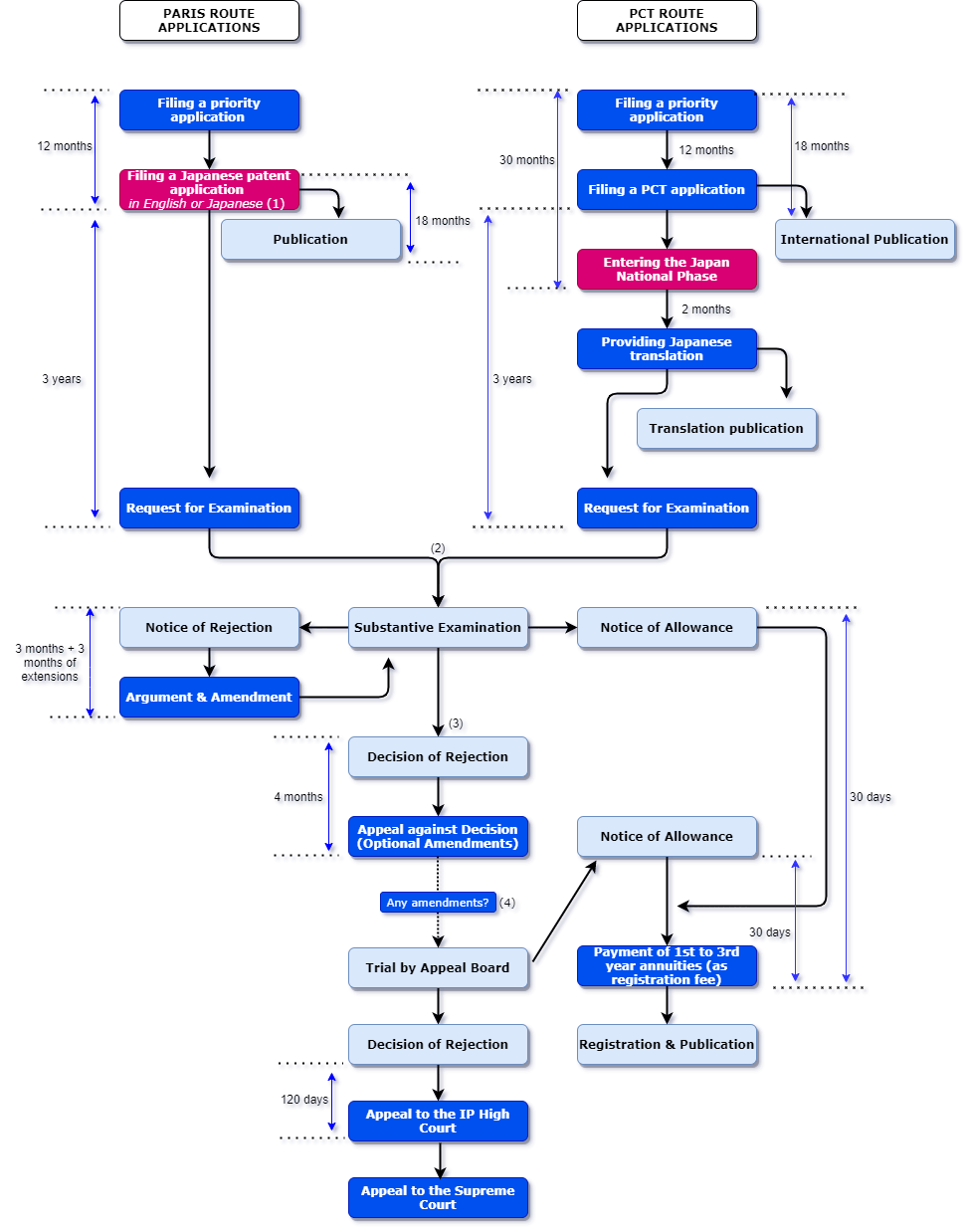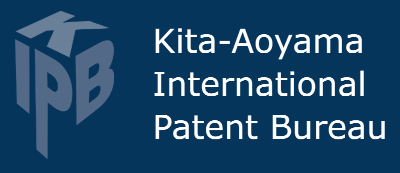An Introduction to Filing Patents in Japan
Welcome to KIPB’s Resources section for those considering filing patent applications in Japan. This guide provides a clear overview of the patent prosecution process, both before and after filing, along with practical information on topics most relevant to overseas applicants.
For further explanations, please visit our
Patent System Q&A section, where you will find accessible answers to many of the questions we commonly receive from international clients. We hope you find these materials helpful. If you cannot find the information you need or have case-specific inquiries, please feel free to contact us at any time—we will be happy to assist.
Please click on the topics below for more details.
Options for international applicants filing into Japan
Most patent applications filed by overseas applicants into Japan are based on domestic patent applications that have already been filed at the national patent office in the applicant’s home country, such as the US Patent and Trademark Office or the UK Intellectual Property Office.
Overseas applicants into Japan can choose one of two filing routes for this procedure - the PCT Route or Paris Convention Route.
The Patent Cooperation Treaty (PCT) is an international treaty signed by over 150 member States. It allows applicants to file a single international patent application covering all of these States which, for a certain period of time, takes the place of each of the separate foreign patent applications that would otherwise be required for protection abroad.
The PCT filing route includes two basic stages (phases) – the international phase and the subsequent national phase.
At the international phase, an applicant files a single international patent application based on the domestic "priority" application filed in their own country. International patent applications should be filed within one year from the filing date of the domestic application They are thus counted as having the same filing date as the domestic application (or "priority date"). Priority dates are extremely important in determining patent rights.
At the subsequent national phase, the applicant selects which specific countries they wish to file their international application in. At the deadline for filing at the national phase, the international application converts into separate "national" (domestic) applications according to the countries selected. These applications are thereafter prosecuted individually according to the IP laws in each country.
The time frame for the PCT application process in Japan is as follows:

The Paris Convention is an agreement on industrial property rights between 177 contracting member countries. It guarantees that when an overseas applicant files an IP application in another member country, the application receives the same treatment as if the application was filed by a national of this other member country.
The Paris route allows overseas applicants to file applications in individual countries directly, and in non-PCT treaty countries like Taiwan (at time of writing). Effectively, applicants file an application in their own country from which they can claim priority as per the PCT route (see above). Then, instead of filing a single international PCT application within a year, applicants apply separately to individual countries such as Japan. As long as the application is filed in Japan within one year from the filing date of the corresponding domestic application it is counted as having the same filing date (or “priority date”). Priority dates are extremely important in determining patent rights.

There are advantages and disadvantages to both filing routes depending on the applicant's particular requirements. The PCT route generally gives an applicant more time and options in deciding which countries to file in. However, the Paris Route generally offers more costs savings and flexibility for applicants who want to file in fewer, specific countries, and obtaining a patent is usually quicker.
The KIPB Team can help you decide which route is better for you to take. Contact us at any time.
If you would like more information on how to use the two systems before applications reach the filing stage in Japan, please see the following explanations provided by the World Intellectual Property Organization (WIPO):
After your application has entered Japan
- If the application is filed in a foreign language application (English), it is necessary to submit a Japanese translation within 2 months of filing or within 14 months of the priority date.
- The JPO officially stated policy is to examine an application within 9-10 months from the Request for Examination. This is the shortest turnaround amongst all major patent countries.
- A Final Decision of Rejection is often issued after the first or second Notice of Rejection.
- Amendments are optional at the Appeal stage.
- If none are made, the application goes straight to the Trial by the Appeal Board (typically 3 or 5 new examiners).
- If amendments are made, the existing Examiner will perform a pretrial examination and either issue an allowance or provide recommendations to the Appeal Board. If the case goes back to the Appeal board, the appeal trial proper begins, at which the Appeal Board will issue:
- Patent specification, claims and drawings;
- The front page of the international WIPO Publication;
- Any amendments under PCT article 19(1) and/or 34(2) (if any); and
- A copy of the International Preliminary Examination Report.
- Patent specification, claims, drawings and abstract;
- Full name, address and nationality of each inventor;
- Full name, address and nationality of each applicant and their identification number at the JPO (if they have one)
- The filing date of each priority application;
- The application number of each priority application (if available); and
- The priority documents including the country filed (filed within 16 months from the priority date).
- (i) industrial applicability,
- (ii) clarity,
- (iii) novelty or inventive step over the prior art,
- (iv) support in the description, or
- (v) enablement from the description.
Once you have filed your patent application in your own country and have selected Japan as a country you wish to file in - via either the PCT or Paris filing routes and according to the legal time frames - your application moves into the domestic filing stage in Japan. We provide an overview of the prosecution of your application in Japan below – from filing to patent grant and beyond.
Again, please also see our Patent System Q&A for specific details. The KIPB Team are very happy to provide any explanations and advice upon request. Contact us at any time.

Notes:
i) an Allowance (overturning the previous Decision), or
ii) a Decision to reject, or
iii) a discretionary Notice of rejection which may give the applicant the opportunity to make a further response/amendment into an allowable condition.
For PCT applications, an applicant has 30 months from the date of filing their domestic priority application (i.e., the application in their own country) or the filing date of their international PCT application if they first filed with the World Intellectual Property Organisation (WIPO) based in Switzerland, to decide whether to enter a particular country’s national phase.
For Paris route applications, filing is within 1 year of the priority application.
PCT
To enter the PCT national phase in Japan an applicant needs to provide the following documents.
These must be filed by the 30-month priority claim deadline.
Japanese translations can be provided within 2 months from the recorded date of Japan national phase entry.
PARIS
The following documents are required to file a Japanese patent application using the Paris Route (and maintain priority claim):
Paris route applications can be filed in languages other than Japanese initially (English being the most common), in which case, a Japanese translation should be provided within 1 year and 4 months from the earliest priority date.
--------------------
Application number and Applicant ID
Applications are issued with an initial application number on the day of filing (Paris route and domestic filings) or soon thereafter (PCT).
New applicants are also given a general applicant ID number from the JPO if they haven’t already received one for a previous application (ID numbers are useful when an applicant’s name / address changes, for example - the change being applied to the ID number and automatically applicable to all pending cases.)
POA
No power of attorney (POA) is required at this stage for PCT or Paris route applications. POAs are only required for special circumstances later on in the prosecution such as at the time of an Appeal or Opposition, or to record a name change, etc.
The KIPB Team can provide advice on these documents and can provide the necessary Japanese translations from any language. Contact us at any time.
PCT
Japanese translations should be provided within 30 months from the first priority date of the PCT application or within 2 months from the date of national phase entry into Japan (whichever is the later date).
The translation must be exactly the same as the content in the original PCT document with no new matter added. Amendments that are supported by the content in the original can subsequently be made freely to claims up until a first office action is issued (and thereafter, if the office action is not "Final".) We usually recommend filing any claim amendments with the request for examination (below) since examination fees depend on claim numbers.
PARIS
We can currently file in any language to maintain the priority date (which is 1 year before the Japanese application deadline) and subsequently provide a Japanese translation within 16 months from the priority date.
Amendments can subsequently be made in the same manner/time frame as for PCT applications above.
Note that it is common to file both PCT and Paris route applications in a foreign language in Japan and then have them translated. This gives the applicant a certain amount of leeway with respect to how Japanese translations conform to the original application –i.e., you can amend errors/support in the translation if this falls within the scope of the original foreign language document.
The KIPB Team are fully set up to provide timely and accurate translations in-house by our experienced IP specialists. Contact us for details.
After a certain period of time, applications are published in the JPO's Patent Gazette and on the JPO online database J-PlatPat, and given a publication number.
Domestic and Paris Convention filings are published 18 months after filing. PCT applications entering the Japan national phase are published about 7-8 months after their Japanese translations have been submitted (which is within two months of national entry.)
Applications are searchable by other parties at this point, and anyone can submit prior art that may be of relevance during the subsequent examination.
The next important milestone for the patent prosecution timeline is the applicant’s obligation to request examination.
PCT
A Request for Examination must be filed within 3 years from the international PCT filing date.
PARIS
A Request for Examination must be filed within 3 years from the date of filing in Japan.
Accelerated Examination
The examination process to first office action can be accelerated in a number of ways when Requesting Examination provided certain conditions are met (for example, the Japanese application has a corresponding application filed elsewhere).
Standard examination to first JPO response usually takes around 9 or 10 months (as of Oct. 2020) before the first response from a Japan patent examiner. Whilst this is the quickest turnaround time of any major patent jurisdiction, requesting any form of accelerated examination reduces this period still further to around 2 to 3 months.
After a Request for Examination, an Examiner will be assigned to the application and he/she will issue a Notice to Reject or allow the application – the latter much rarer straight off (a so-called "Office Action"). Rejection is usually not the end of your application, rather it represents a chance to clarify your invention or differentiate it from existing patents. There are various reasons an Examiner might issue a rejection, some main ones including lack of:
Types of Office Action
Notice of Rejection
The first judgment on the patentability of an application is usually a "Notice of Rejection". A "first" office action allows the applicant to amend claims feely in response (within the scope of the disclosure). An applicant has 3 months to respond (extendable for a small fee in case of foreign applicants)
"Final" Notice of Rejection
If a new reason for rejection is found due to the amendments made by the applicant in response to the "first" Notice of Rejection above, a "final" Notice of Rejection may be issued. Subsequent scope for amendments is much more limited in this case (i.e., to limiting, cancelling, correcting or clarifying claims.)
Decision of Rejection
An amendment/argument in response to the above Notices of Rejection that fails to convince the examiner will result in a Decision of Rejection. An applicant's options, in this case, are to file an Appeal and/or a Divisional application (within 4 months of the decision, for cases filed after 31 March 2007.) Amendments are optional for an Appeal but again are limited in scope.
Notice of Allowance (Decision to Grant)
When an examiner finds no reason to reject an application, he/she decides to grant a patent. In this case, the applicant must pay a registration fee within 30 days of the grant decision in order to obtain the patent right (and certificate of patent). The applicant may also file divisional applications within this period
Voluntary amendments can be made to the claims, drawings and text at any time before a first office action and within the period for responding to an office action. They can also be filed with an Appeal. Amendments in response to non-final office actions are unrestricted in scope (provided they are properly supported by language in the description of the application). After that, the amendment scope is much more restricted.
Divisional applications give an applicant more time to consider their claim options. They allow rejected/cancelled claims to be kept alive or for the applicant to pursue a different technical feature or embodiment that is supported but not claimed in the original application.
There are ample time periods when a divisional can be filed, but some restrictions. See our Patent System Q&A for details.
An applicant can challenge a Decision of Rejection by requesting an Appeal. A board of 3 new examiners will be appointed to review the Decision. Amendments are optional, but if made, the original examiner will examine them once again before the actual Appeal and grant or issue his/her recommendations to the Appeal board.
If the Appeal is rejected the applicant has the option of submitting a complaint about the correctness of the appeal procedure to the Japanese IP High Court within 30 days.
After allowance, an application will be published in the Patent Register/Gazette once a registration fee is paid within 30 days of allowance. It will be given a patent number and a Certificate of Patent will be issued to the applicant. The patent remains valid for 20 years provided regular annuity fees are paid. Except for certain pharmaceutical and agricultural-based patents, these terms cannot be adjusted.
Divisional can also be filed before payment of the registration fee (provided the application has not been granted via an Appeal.)
Registration is often not the end of the prosecution of a patent. The patent holder may want to license the rights to a third party. The patent may also be challenged by other parties with similar inventions, or it may be infringed upon by similar or later products or technologies which do not have permission to do so. A brief overview follows:
OPPOSITION
Any third party can file “oppositions” within six months from the publication of a patent in the Patent Gazette. The grounds for opposition are similar to those in an office action and are provided in writing by the opponent. The opposition will be considered by a board of three examiners and if they find the arguments valid, the patent holder will be given the opportunity to amend as per the restrictions in a Final Office Action.
INVALIDATION
A third party with a ‘commercial interest’ in the technology pertaining to a patent may request a trial for invalidation at any time during the patent’s life. Grounds are similar to those in an office action. The trial is an inter partes procedure that is heard by an appeal board. If they find the invalidation request has merit, the patent holder is given a chance to correct/clarify/limit claims by amendment to cancel the invalidation.
TRIAL FOR CORRECTION
A patent holder (only) can request a trial for correction (sometimes called “trial for re-examination) to correct/clarify patented claims, etc. They might do this if they anticipate their registered claims etc. are at risk of being invalidated, or if errors - including translation errors - are discovered. Corrections of patented claims can also be made when an Invalidation Trial is demanded by a third party (the patent holder cannot request a separate correction trial during this period). Acceptable amendments can only restrict the scope of claims, not broaden; and should remain within the scope of the original disclosure.
LICENSING AND INFRINGEMENT
The patent can then optionally be monetized via a licensing agreement. The patent right holder or licensee may also seek injunctions or compensation for damages when somebody else infringes their exclusive or licensed rights to use the patent.



